Jira is a leading tool for issue tracking and project management, supporting over 65,000 companies in creating workflows that deliver reliable results. Originally built for software development, Jira now serves a wide range of industries and use cases, such as asset management, project portfolio management, and employee onboarding, while also helping teams adopt agile practices.
But Jira’s powerful features come at the cost of complexity. Getting the most out of Jira requires both customizing it to meet your unique business requirements and getting all your team members aligned on how to use it. This straightforward guide will quickly get you started, covering everything from issues and subtasks to integrations and plugins.
Summary of Contents
Before You Start: Purchasing a Jira License
Getting Started with Jira Step-by-Step
- Create and Structure a Project
- Set up Boards
- Build Workflows
- Create Issues
- Build Out Reports, Dashboards, and JQL
- Leverage Integrations and Connect Your Tools
- Select and Install Plugins
Before You Start: Purchasing a Jira License
Before you can start using Jira, you need to evaluate its three versions — Software, Service Desk, and Core — and its hosting options — Server, Cloud, and Data Center — to determine how you can best meet your business needs while staying within budget.
Each version of Jira is designed for distinct use cases:
- Jira Software comes with the most robust project management capabilities, including support for agile project management.
- Jira Service Management is intended for addressing customer issues.
- Jira Core lacks the agile project management functionality of Jira Software, but it can still meet most project management needs.
Carefully consider the available hosting options for Jira as well. Jira Cloud provides organizations with the convenience of a Jira instance hosted by Atlassian. It is most appropriate for companies that don’t have the resources to host a Jira deployment themselves and lack any unusual scaling or performance requirements. Both Jira Server and Data Center require organizations to host a Jira instance using a third party cloud provider or their own infrastructure and provide additional scaling, management, and security options. Organizations on Jira Cloud can migrate to Jira Server or Data Center if they need the additional flexibility and power later on.
The cost for any Jira deployment is based on the number of users in your organization. That number determines the monthly, annual, or one-time pricing tier you fall into.

Getting Started with Jira Step by Step
Accomplishing anything in Jira requires becoming familiar with its fundamental concepts and features. This guide moves through the process of using Jira step by step, explaining each concept and how to employ it in turn.
1. Create and Structure a Project
All work in Jira is grouped into projects that can consist of any number of discrete tasks — called “issues” in Jira. Projects can consist of anything from a few issues for following up on sales leads to hundreds of issues related to developing a new product.
Creating a project in Jira takes only a few minutes:
- First choose Projects from any Jira screen, then select View all projects.
- Click on Create project and then choose Classic project or Next-gen. Classic projects use standard configurations that can be duplicated across projects, while next-gen projects offer the flexibility of individual configuration at the cost of less customizability.
- Give your project a name, and select a template like Scrum or Kanban — more on these in the following section covering boards in Jira.
- Select Create, and you’re finished.
If you haven’t yet added your team members to Jira, you can do so by email in both Jira Cloud and Server/Data Center — but don’t forget that the cost of Jira is dependent on the number of users.
Considerations when adding team members
- What permissions you want members to have when working in your new project
- Should everyone be able to create issues?
- What about editing workflows?
To adjust project permission schemes
- Click the gear icon (Settings)
- Select Issue
- Choose Permission Schemes
After creating your Jira project, organize it for success. Here are ways you can structure your Jira Project:
- Set up project categories, components, and versions to categorize and track issues
- Configure workflows, permissions, and notification schemes to align processes
- Establish issue types (e.g., bug, task, feature)
- Define priorities (e.g., high, medium, low) and resolutions
- Review structure to ensure consistent issue tracking
2. Set up Boards
After creating a project, you need to decide how you want to visualize all the work you’ll manage in it by using boards. A board displays issues and allows easy navigation among them. Boards are typically associated with issues from a specific project, but they can also display issues according to a variety of other useful criteria, such as issues that are assigned to a specific user.
Kanban vs. Scrum
There is only one type of board available in Jira Core, but Jira Software users can choose from two primary types of boards: Scrum and Kanban. Scrum is centered around sprints — relatively brief intervals for completing a set work goal — while Kanban focuses on using its titular Kanban boards to manage work and improve efficiency.
Scrum boards in Jira include a backlog that displays issues that currently aren’t being worked on…
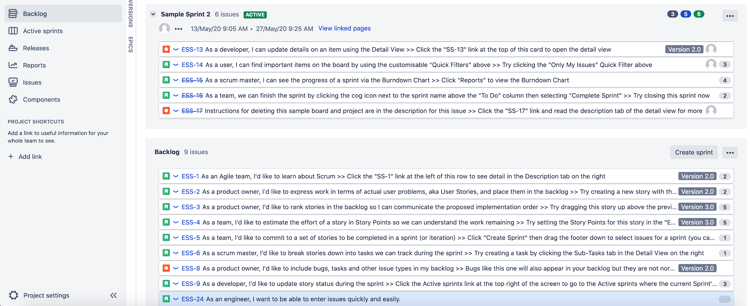
...and a view that shows issues that are part of ongoing sprints.
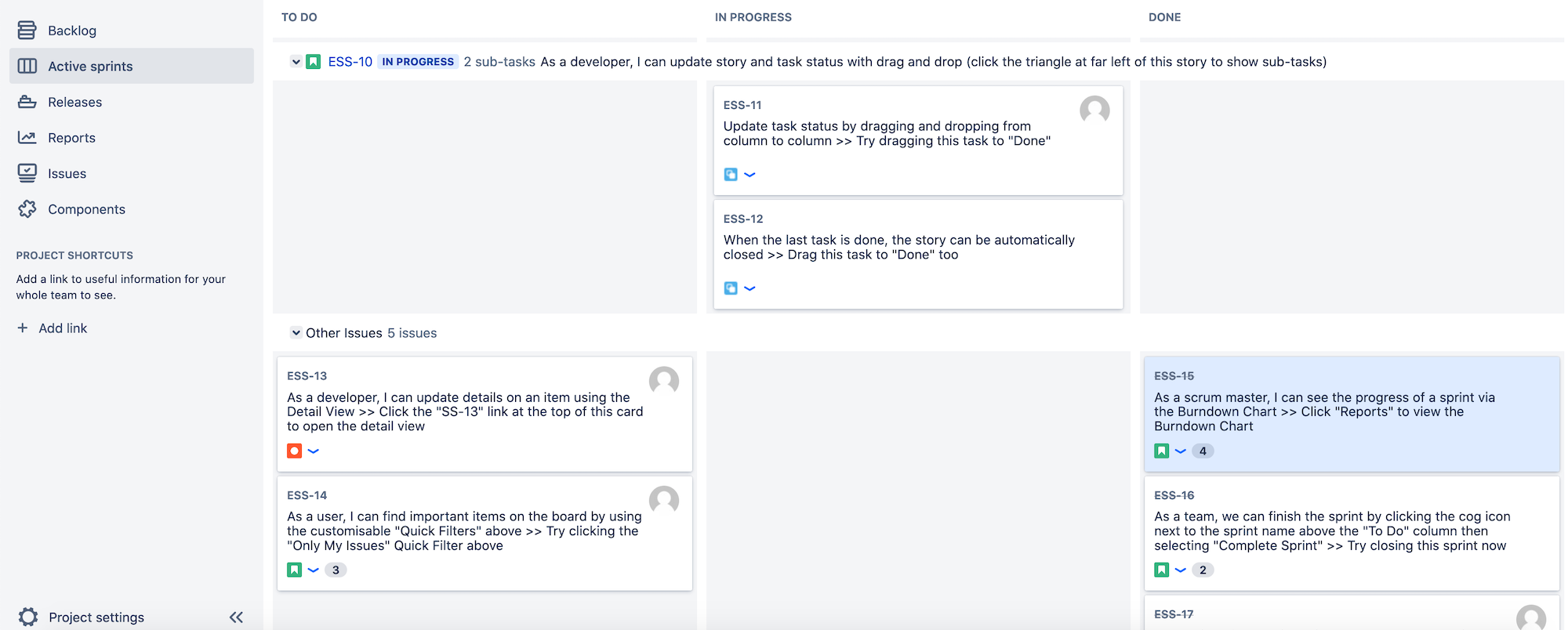
Kanban boards are designed to clearly show issues at various stages of progress so tasks are completed more quickly, everyone can see where a project stands, and you can better manage workloads.
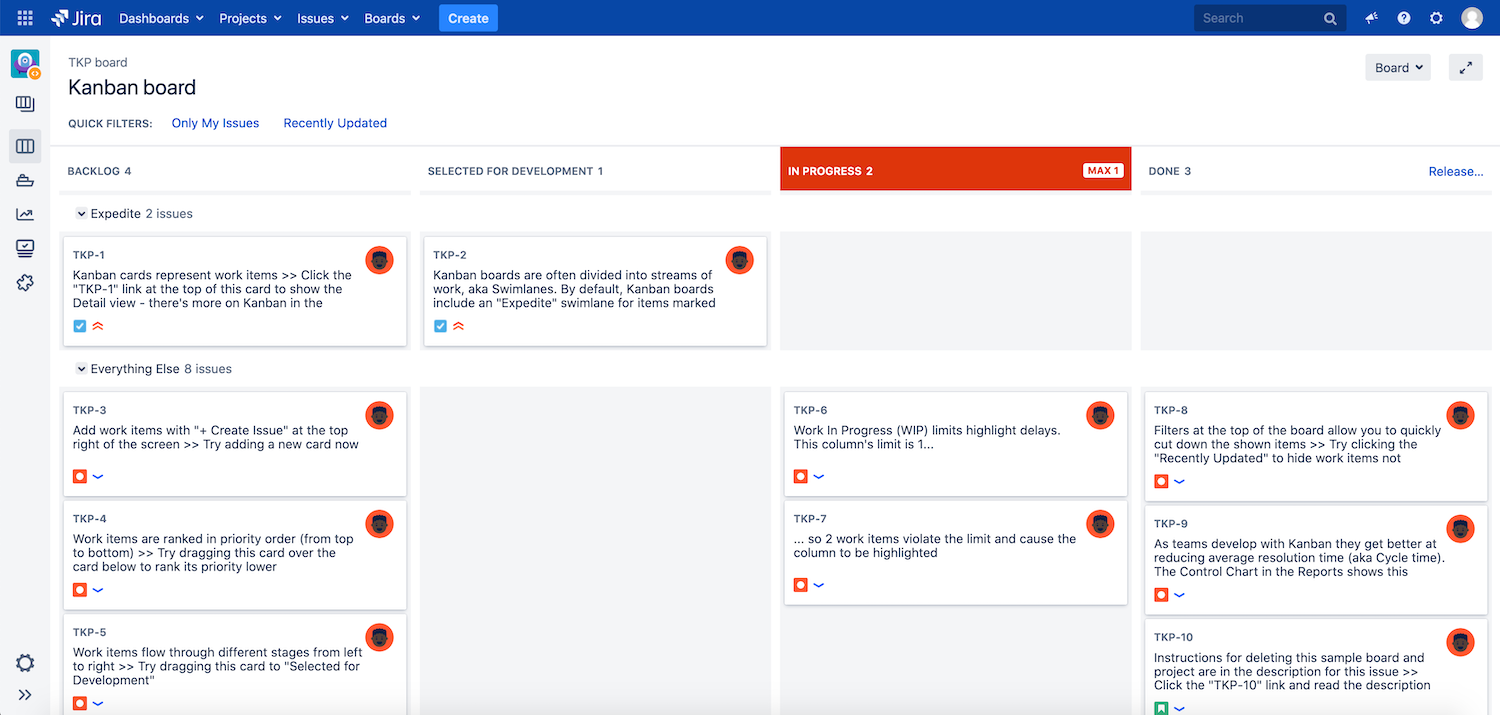
There are benefits to each approach —Kanban offers greater transparency and flexibility, while Scrum provides more structure and definition — so carefully consider which fits your organization best before proceeding.
Steps to Create a Scrum or Kanban Board in Jira
- Click the search field
- Select "View all boards"
- Choose "Create board"
- Select board type (Scrum/Kanban)
- Choose project or create a new one
Customize Your Board
- Use Jira Query Language (JQL) to filter issues
- Refine board display by parameter (e.g., project, status, assignee)
Now that you’ve decided how you want to structure and view work in Jira, it’s time to define the processes users will follow to complete tasks.
3. Build Workflows
Workflows determine the processes that team members will follow when completing issues in Jira. Jira’s workflow capabilities are among its most powerful, and customizing workflows to guide your team members and standardize your important processes is highly recommended. All workflows are comprised of the following parts:
- Statuses: Think of statuses as the steps a workflow moves through — for instance, "Planning," "Developing,” and "Testing." A Jira issue can only have one status at a time.
- Transitions: Transitions connect statuses and determine how the workflow moves from one to another. They allow for creating nonlinear workflows and controlling under what circumstances a workflow can move forward.
- Assignees: The assignee is the Jira user or group responsible for an issue when the workflow is at a specific status.
- Resolutions: Resolutions represent the final result of a workflow, such as “Complete” or “Won’t Do.”
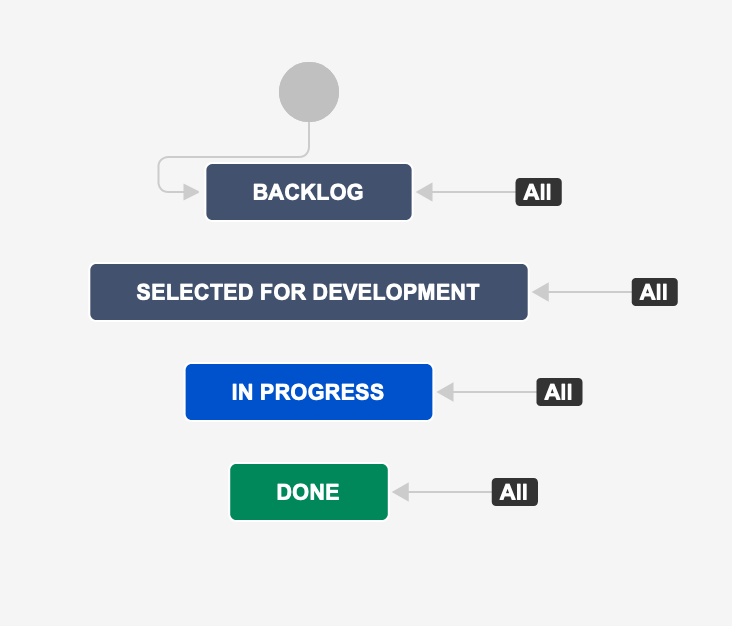
To create a new workflow in Jira, follow these steps:
- Click on the gear-like settings icon, then Issues, then Workflows.
- Choose Add workflow, enter some basic information, and select Add.
- Within the workflow editor, define the steps of the workflow using Add status, and connect the steps using Add transition. You can define as statuses and transitions as you wish, but it’s best to keep your workflow as lean as possible to avoid confusion and maximize efficiency.
- Finally, to add resolutions, navigate back to the Issues menu and click on Resolutions.
Workflow Schemes
Workflows are associated with issues and projects through what Jira calls workflow schemes.
- Go to Issues, then Workflow Schemes, then Add Workflow Scheme
- Select specific workflows and issue types for the scheme
- Go to Projects, then View all projects
- Select a project
- Click Project settings
- Select Workflows
- Click "Switch Scheme" and choose your new workflow scheme
Configuring Workflows
Administrators can further customize workflows by altering four different elements, each with a distinct purpose: statuses, transitions, assignees, and resolutions. This handy infographic explains how you can use each: Contegix’s guide to using workflows.
4. Create Issues
Issues are the units of work that are make up projects. Each issue represents a discrete task that must be completed, although the scope of that task can vary widely, and each contains specific information that helps team members collaborate and stay on track. You can define issue types to represent almost any kind of work imaginable, although all versions of Jira come with some default types that cover many use cases. As discussed above, every issue is associated with a project and workflow.
Create a New Issue
- Click the Create button (+)
- Enter required information
- For example: Assignee and Priority level
- Add optional info (if needed)
- Review and confirm details
- Click "Create"
How to Add a New Issue Type
- Go to the Issues menu and choose Issue type schemes.
- Tip: Ensure the issue type is defined and frequently used to prevent inefficiencies and reporting errors.
- Associate with a project by selecting "Associate" in Issue type schemes.
You can also change an issue’s task by selecting the issue type icon to the left of the issue key when viewing the issue:
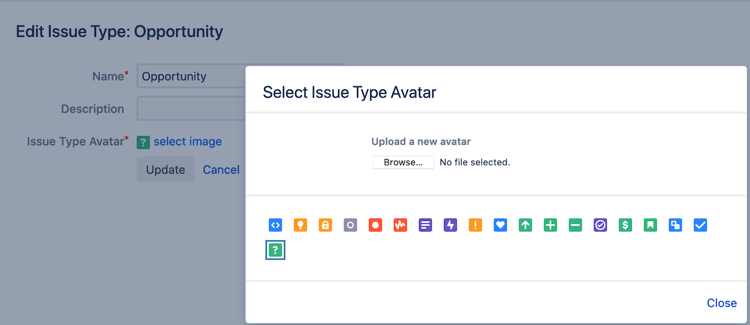
Customize Fields
You can customize the fields for an issue type to change the information displayed on the corresponding issue screens.
- Go to Issues, select Fields
- Click Field configurations
- Add, remove, or modify fields for each issue type
- Tip: Add, remove, or modify fields carefully to avoid clutter or missing vital information.
Security Schemes
You can control who has the ability to view issues in Jira using issue security schemes. Controlling the visibility of issues in Jira allows you to protect sensitive information and even erect screens between teams working for different clients in the same industry.
- Go to Issues, choose Issue Attributes
- Select Issue security schemes
- Create a new scheme
Linking Issues
One of the best ways to organize issues is by establishing relationships between them using links. Linking lets users define how issues relate to each other by establishing connections such as “builds,” “is cloned by,” or “has to be done after.” Links can be created from any issue screen by clicking Link issue.
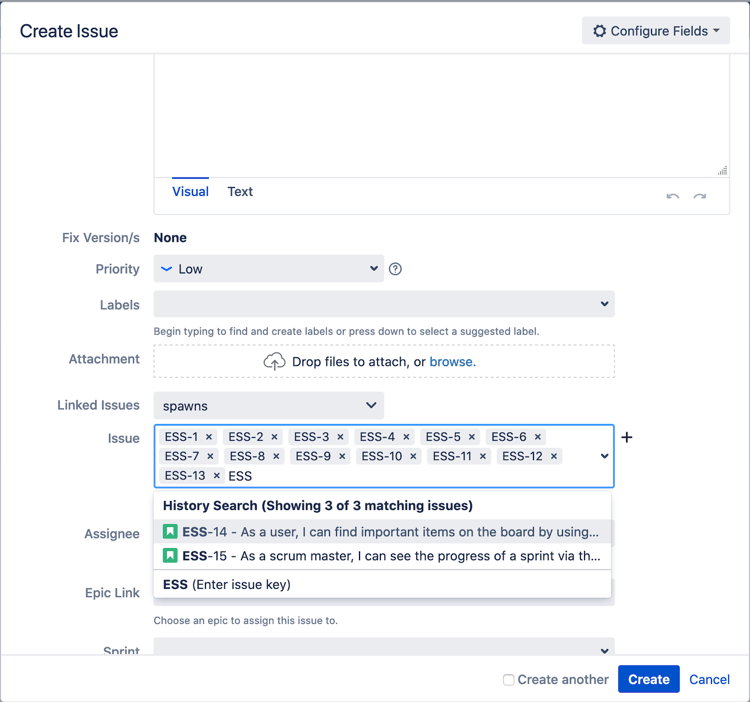
Cloning Issues
Copying an issue within the same project is called “cloning” in Jira. All information — excepting data unique to the copied issue, like its status or the time logged against it — is duplicated to the cloned issue. This makes cloning a fast way to populate a project with issues of the same type without having to repeatedly enter the same information during issue creation.
Cloning an issue is as simple as clicking on the ellipsis icon on an issue screen, choosing Clone, and clicking Create.
Creating Subtasks
Subtasks can be used to define specific pieces of work within an issue that you want to track individually or that need to be assigned to someone other than the assignee for the primary issue. To make a subtask, select Create subtask from an issue screen. If you later need to turn a subtask into a separate issue, click on the icon to the left of the subtask’s issue key.
5. Build Out Reports, Dashboards, and JQL
Jira provides native reporting features that enable users to measure KPIs such as time to completion for select issues. You can create reports by navigating to a board and then selecting Reports. Additional reporting capabilities are available through certain plugins on the Atlassian Marketplace, such as Portfolio, which provides reporting based on roadmapping features that aren’t available natively in Jira.
To learn more about the additional visualization and reporting options available in Portfolio, check out our guide on using Portfolio for Jira
You can also use dashboards for reporting. Dashboards are screens in Jira that you can customize to display certain information using gadgets. Gadgets let you display data related to projects and issues — like issues with a specific label or how quickly issues are being resolved — in a variety of formats, including as a calendar or a heat map. Here are some quick tips for getting started with dashboards:
Create a New Dashboard
- Select "Dashboards" from any Jira screen
- Click "Create dashboard"
- Enter the information and sharing options
- Click "Create"
Edit an Existing Dashboard
- Select "Dashboards" from any Jira screen
- Click "View all dashboards"
- Click the ••• symbol in the dashboard's row
- Update the dashboard name, description, or sharing options
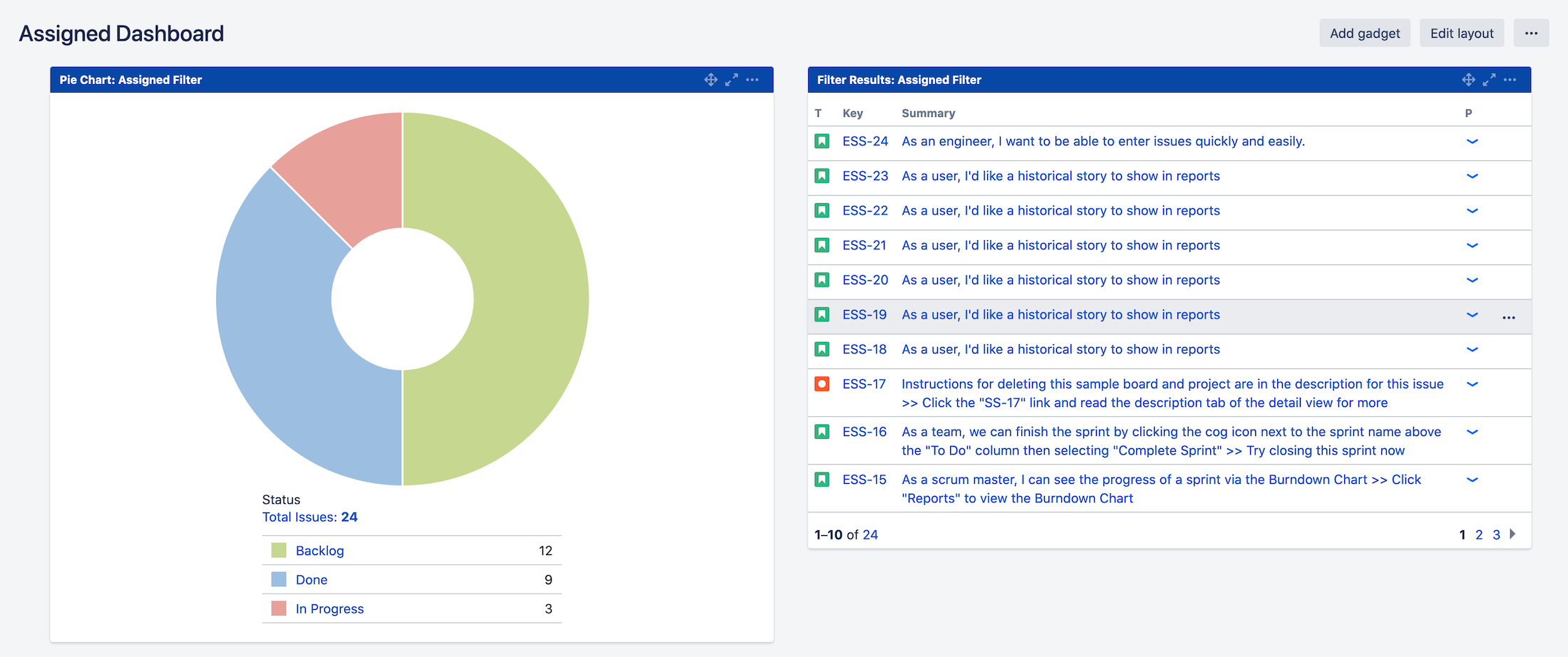
Add Gadgets to a Dashboard
- Open the dashboard you want to modify
- Click "Add gadget"
- Configure the gadget settings
Customize Dashboard Layout
- Open the dashboard you want to modify
- Click "Edit layout"
- Drag and drop gadgets to rearrange them
- Click "Done"
Finally, those familiar with JQL can use it to enhance Jira’s reporting capabilities. As noted above, JQL is the language used to create advanced queries when searching through issues in Jira. JQL queries can be used to find data that would otherwise be difficult to identify — for examples, all issues with the name of a certain product or competitor in any information field. You can save JQL statements as filters which can then be shared with others or even displayed in a dashboard using the Filter Results gadget.
To save a JQL statement, enter your query and then select Save as on the results page. You can use existing filters by selecting Filters on any Jira screen and then selecting View all filters.
6. Leverage Integrations and Connect Your Tools
Jira features integrations with many useful applications both within and outside of the Atlassian Ecosystem. Discover new efficiencies and enhance capabilities by connecting Jira to your daily tools. Integrations are easily enabled through plugins. Integrations with third-party tools are usually facilitated through plugins.
Check out some of the most common tools that can connect with Jira:
- Slack & Microsoft Teams: Receive automated notifications, create issues, and track progress directly from your chat platforms.
- Email: Turn emails into Jira issues with ease, ensuring seamless communication and task management.
- Google Drive & Trello: Sync your files and boards to access all project information in one place.
- GitHub & Bitbucket: Track code changes, commits, and deployments without leaving Jira.
One of the most valuable platforms you can integrate with Jira is Confluence, a content management tool that allows users to create knowledge bases and organize written information. Confluence’s content management capabilities complement Jira’s project management features, so users can seamlessly move between issues and related documents.
For more information on using Jira and Confluence together, check out our guide to integrating them.
7. Select and Install Plugins
There are over 3000 plugins for Jira — also referred to as “apps” or “add-ons” — available on the Atlassian Marketplace. Plugins are additional pieces of software that provide critical features that aren’t offered natively by Jira, including:
- Enhancing workflows through greater customization and automation
- Security and single sign-on for ease of use and keeping your Jira deployment safe
- Time tracking so your team members can accurately track their hours and you can discover new ways to improve efficiency
- Advanced scripting for altering how Jira behaves and appears
Jira administrators can install most plugins using Jira’s built-in Universal Plugin Manager (UPM). To do so, click the gear-like settings icon and select either Manage Apps or Add-ons. You can then install most plugins with a single click using the Install button.
Need more information on what plugins are available and how to use them? Take a look at our guide to Jira plugins.
Maximize Your Jira Investment
You're now equipped to unlock Jira's benefits in your organization. However, customizing workflows or migrating between Jira Cloud, Server, and Data Center may still pose challenges. As a Platinum Atlassian Solution Partner, our expert team is here to help align Jira with your business goals and overcome advanced tasks. Start making Jira work for you by contacting us today.
